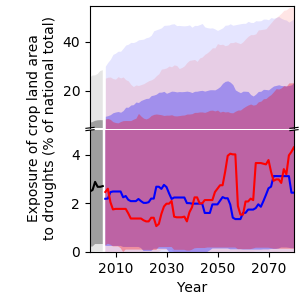Côte d’Ivoire: Agriculture
Smallholder farmers in Côte d’Ivoire are increasingly challenged by the uncertainty and variability of weather that climate change causes [25]. Since crops are predominantly rainfed, yields depend on water availability from precipitation and are prone to drought. However, the length and intensity of the rainy season is becoming increasingly unpredictable and the use of irrigation facilities remains limited due to low levels of mechanisation and lack of public investment [7]. The national crop land suitable for irrigation is estimated at 430 685 ha. Currently, only 8 % of this area is irrigated [7].
Crop land exposure to drought

The high uncertainty of water availability projections (Figure 10) translates into high uncertainty of drought projections (Figure 11). According to the median over all models employed for this analysis, the national crop land area exposed to at least one drought per year will barely change in response to global warming. Under RCP6.0, the likely range of drought exposure of the national crop land area per year widens from 0.2–7 % in 2000 to 0.1–23 % in 2080. The very likely range widens from 0–25 % in 2000 to 0–54 % in 2080. This means that most models project a significant increase in drought exposure over this time period.
Crop yield projections

Climate change will have a negative impact on yields of maize, millet and sorghum (Figure 12)6. While maize is sensitive to hot temperatures above 35 °C, millet and sorghum usually tolerate hot temperatures and dry periods better [26]. Still, model results indicate a negative yield trend for all three crops under both RCPs with a stronger decrease under RCP6.0. Compared to 2000, yields are projected to decline by 9 % for maize and 10 % for millet and sorghum by 2080 under RCP6.0. Under RCP2.6, yields of maize, millet and sorghum are projected to decline by 5 %. Yields of rice and cassava are projected to gain from climate change. Under RCP6.0, crop yields are projected to increase by 5 % for rice and 22 % for cassava by 2080 relative to the year 2000. Under RCP2.6, yields of rice and cassava are projected to barely change. These positive results under RCP6.0 can be ascribed to the CO2 fertilisation effect, which benefits plant growth. Rice and cassava are so-called C3 plants, which follow a different metabolic pathway than maize (C4 plant) and benefit more from higher concentration pathways. However, projections of rice and cassava are characterised by higher modelling uncertainty. Hence, it is likely that crop yields will increase more strongly in some areas and, conversely, decrease more strongly in other areas as a result of climate change impacts.
Overall, adaptation strategies such as switching to improved varieties in climate change sensitive crops should be considered, yet carefully weighed against adverse outcomes, such as resulting decline of agro-biodiversity and loss of local crop types.
6 Modelling data is available for a selected number of crops only. Hence, the crops listed on page 2 may differ. Maize, millet and sorghum are modelled for all countries except for Madagascar.
References
[7] FAO, “Adapting Irrigation to Climate Change (AICCA): Côte d’Ivoire.” Online available: http://www.fao.org/in-action/aicca/country-activities/cote-divoire/background/en [Accessed: 27-Jan-2020].
[25] D. Noufé, G. Mahé, B. Kamagaté, Servat, A. Goula Bi Tié, and I. Savané, “Impact du changement climatique sur la production agricole: le cas du bassin de la Comoé en Côte d’Ivoire,” Hydrol. Sci. J., vol. 60, no. 11, pp. 1972–1983, 2015.


